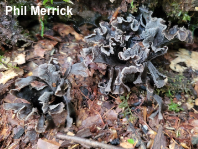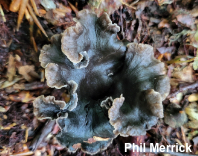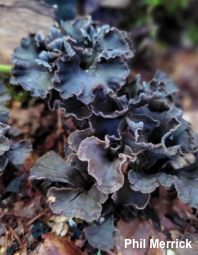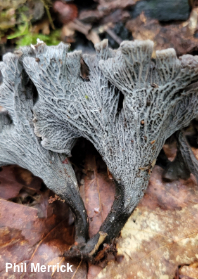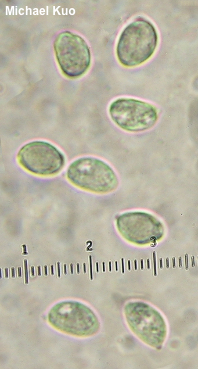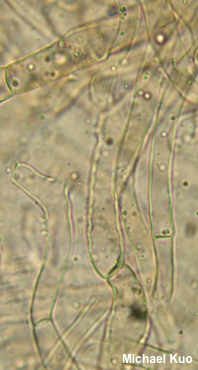| Major Groups > Chanterelles and Trumpets > Craterellus cinereus |

|
[ Basidiomycota > Cantharellales > Cantharellaceae > Craterellus . . . ] Craterellus cinereus by Michael Kuo, 10 November 2022 This distinctive, vase-shaped mushroom features dark gray to black colors on the cap, and a paler undersurface that is wrinkled with veins and false gills. It is usually found in association with beech trees—often in the vicinity of better-known "black trumpets" like Craterellus fallax (in North America) or Craterellus cornucopioides (in Europe). However, the black trumpets have smooth undersurfaces and poorly defined stems, and are easily separated from Craterellus cinereus. In North America Craterellus cinereus should also be compared with Craterellus foetidus, which is more pale and has a less clearly defined, more hollow stem. Craterellus venosus, described from Nova Scotia (Petersen 1975), may be a synonym, as well as Michigan's Craterellus caeruleofuscus. A California version has been given a species name in a non-peer-reviewed setting without a shred of scientific support; it may also be a synonym. In a recent DNA study (Zhang et al. 2022) the California mushroom grouped far from collections labeled "Craterellus cinereus" from south Asia, but the latter mushrooms may well be misidentified, and the world awaits a thorough study of cinereus-like collections in which central European material (which would by necessity constitute the type locality) is compared to North American and south Asian collections. Craterellus cinereus multiplex, described by Smith from northern Michigan (1953), is a probable synonym for Craterellus undulatus—a paler and browner species with a less "gilled" undersurface. Thanks to Phil Merrick for documenting, collecting, and preserving Craterellus cinereus for study; his collection is deposited in The Herbarium of Michael Kuo. Description: Ecology: Mycorrhizal with beech (European and North American), and perhaps with other hardwoods; growing gregariously or in clusters; summer and fall; originally described from central Europe (Persoon 1794); widely distributed in Europe and North America; also reported from southern Asia. The illustrated and described collection is from Vermont. Fruiting Body: 1–4 cm wide; 4–8 cm high; usually with a clearly defined cap and stem. Cap: 1–4 cm across; initially planodepressed to shallowly depressed, becoming more vase-shaped and developing a central perforation; the margin wavy and sometimes somewhat lobed; surface bald or very finely scaly, moist, dark gray to black, with a paler, brownish margin. Under/Outer Surface: Running down the stem; with blunt false gills, gill-like folds, veins, and cross-veins; pale gray to bluish gray. Stem: 3–5 cm high; 0.5–1 cm thick; tapered to base; occasionally joined near the base with other stems; bald; black; basal mycelium white. Flesh: Thin and brittle; gray to blackish. Odor and Taste: Usually strong and sweet. Microscopic Features: Spores 7–9 x 5–6 µm; ellipsoid; smooth; hyaline in KOH. Basidia 50–60 x 5–7 µm;; clavate; 4- or 6-sterigmate. Hymenial cystidia not found. Elements of upper surface cylindric; septate; hyaline to brownish (en masse); 6–12 µm wide. Clamp connections not found. REFERENCES: (C. H. Persoon: E. M. Fries) M. A. Donk, 1933. (Smith, 1968; Petersen, 1975; Bigelow, 1978; Smith, Smith & Weber, 1981; Arora, 1986; Breitenbach & Kränzlin, 1986; Phillips, 1991/2005; Vila, 2006; Contu et al., 2009; Cuesta et al., 2009; Olariaga et al., 2009; Siegel & Schwarz, 2016; Kibby, 2017; Elliott & Stephenson, 2018; Læssøe & Petersen, 2019; Zhang et al., 2022.) Herb. Kuo 09212201. This site contains no information about the edibility or toxicity of mushrooms. |
© MushroomExpert.Com |
|
Cite this page as: Kuo, M. (2022, November). Craterellus cinereus. Retrieved from the MushroomExpert.Com Web site: http://www.mushroomexpert.com/craterellus_cinereus.html |
